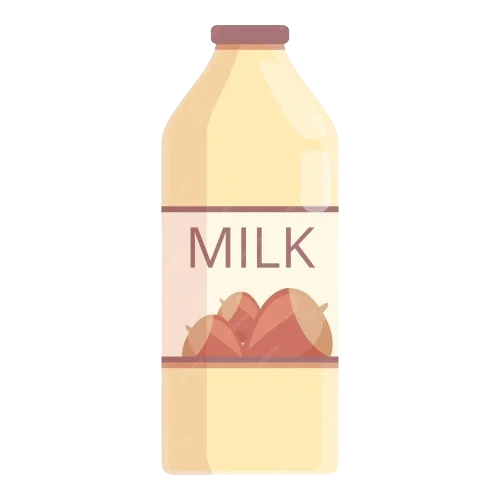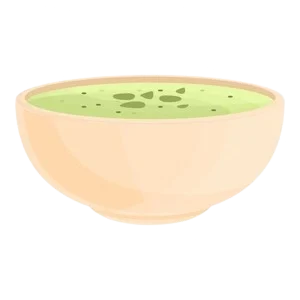REPLACING DAIRY PRODUCTS? IT'S EASY! 
There are more and more 100% plant-based products available to replace animal products! The range of plant-based alternatives is expanding all the time and is becoming increasingly available in supermarkets and organic or vegan shops.
We have vegetable milks, creams, margarines, yoghurts and even vegetable cheeses at our disposal to make the dishes we want! These products can easily replace dairy products in many recipes. Choose them according to your taste, habits and budget.
Their nutritional composition varies and can be very different from that of milk and its derivatives, but don't be alarmed: a varied plant-based diet will provide us with all the calcium our body needs!
CALCIUM WITHOUT DAIRY? 
It is not necessary to suffer, it is possible!
Calcium, an essential nutrient for the growth and solidity of bones, is often associated with dairy products. However, many plant-based foods also contain it!
Most plant-based milk and yoghurts are enriched with calcium at levels equivalent to those of dairy products. Tofu prepared from calcium sauces is also a good source: 100g of tofu provides approximately 50% of our daily requirement.
Green vegetables such as spinach, broccoli, celery and green mushrooms are good sources of calcium. Other plant foods are not as rich in calcium but still provide significant amounts, especially dried fruits, tarongs and legumes.
Finally, some calcium waters (e.g. Font Vella) contain calcium, sometimes up to 500 mg/L, which is absorbed just as well as calcium from food!
The World Health Organisation established many years ago that a minimum of 525mg of calcium should be consumed every day, regardless of the food we eat: below this threshold, the risk of calcium deficiency is very high. below this threshold, the risk of fracture increases.By drinking a glass of fortified soya milk (200ml), we already reach almost 50% of this daily recommendation: there is no need to consume dairy products to have solid bones!
For good bone health, calcium must go hand in hand with an adequate amount of vitamin D. In our temperate countries, sunshine can meet our needs during the summer.However, supplementation is recommended during the winter, whether we are vegan or not: the majority of the population does not reach the recommended levels of vitamin D.

TO KEEP IN THE CUPBOARDS 🧺
- Vegetable milk, ideal as a substitute for milk in any of its uses. Tastes vary depending on the brand: try different brands to find your favourite. Some milks contain added sugar, sometimes cane sugar or fruit juice, especially those enriched with calcium. Beware, plant-based milk cannot replace breast milk for breast-feeding babies.
- Vegetable creams: soya, rice, oat, almond, coconut... try them to find your favourite! Soya cream is the most multi-purpose and the easiest to find in shops and supermarkets.
- Margarine or vegetable oil instead of butter.

CAN VEGETABLE MILKS CURDLE? 
Soya milk, like animal milk, curdles when vinegar or lemon juice is added: just mix 200 ml of soya milk with 1 tablespoon of lemon juice or vinegar, boil it and let it stand for a few minutes. This preparation can be used for various recipes, such as vegetable cheeses.
VEGETABLE MILKS FOR ALL TASTES 
Soya milk, widely available in supermarkets, is the milk with the most variable flavour depending on the brand. It can be used in any recipe. Be careful when cooking: it can spill, just like cow's milk!
Rice milk has a fairly liquid texture and a sweet taste. It is usually found in combination with other nuts or cereals: rice-hazelnut, rice-coconut, rice-quinoa, rice-almond, etc., which adds some creaminess to its texture.
The gourmet taste of almond or hazelnut milk is perfect for desserts - they are a real treat!
There are many other varieties of vegetable milks, based on cereals (oats, millet, spelt, barley, quinoa) or oilseeds (chestnut, coconut, etc.), each with its own particularities. Each has its own particularities, so let's discover them!
Infant milks, or infant formula, are preparations specifically designed for the nutritional needs of babies. There are several vegetable versions, based on rice, almond or soya. Enriched with vitamins and minerals to meet specific needs, they are equivalent to infant milks based on cow's milk. In the same way that giving non-maternalised cow's milk to a baby before the age of one year would be dangerous for its health, non-vegan plant-based milks are not adapted either.
Find out more about vegan baby food:
VEGETABLE CREAMS AND BÉCHAMEL 
Some preparations similar to liquid cream exist in the form of small tetrabriks. Depending on the type and brand, they can be sweeter or less sweet and thicker and have a stronger or weaker taste. Soy cream, coconut cream, oat cream, spelt cream, rice cream, almond cream... discover them in your supermarket or organic or vegan shop.
Lacto-fermented soya (no dairy product required) or crushed silken tofu can be used as an equivalent to cream.
As for béchamel, some brands offer a vegan preparation that can be used for baking. Homemade béchamel sauce made from soya milk is also very easy to make.
Nut spreads (almond, hazelnut, cashew, sesame) are perfect for spreading on bread and give a creamy result when used in cooking: they add flavour and smoothness to soups, sauces, mashed potatoes and cake garnishes.
ALTERNATIVES TO BUTTER 
Margarines, some of which are vegan, are the simplest alternative for baking. Depending on the recipe, other fats can be used, such as oils or nut spreads. It is preferable to use oils that can withstand cooking and have a neutral taste: peanut oil, sunflower oil or even olive oil in some recipes.
Nut spreads are also real vegetable butters, delicious as a spread!

YOGHURTS AND DESSERT CREAMS 
We can find yoghurts and dessert creams made from soya, rice or hemp both in large supermarkets and in organic shops. We can find natural yoghurts, yoghurts with fruit, chocolate, vanilla, pistachio, coffee, etc. Soya milk can also be used as a base for homemade yoghurts.
WHIPPED CREAM ON THE POINT! 
You can buy ready-made whipped cream in vegan shops. For best results, as with the traditional whipped cream recipe, refrigerate the bowl and the cream before whipping with a whisk for at least 5 minutes. We can also whip the thick coconut milk, the thicker part we find on top when we leave the coconut milk in the fridge and it is separated into two parts as we found it.

CRUELTY-FREE CHEESES 
Specialty shops (vegan or organic) and some supermarkets offer products that resemble different types of cheese. Some, such as those resembling fresh cheese spreads or hard (sliced) cheeses, are becoming available in supermarkets.
Nutritional yeast is a good alternative to grated or powdered cheese. In sauces, gratins, pastas and vegetable patés, it can easily replace the cheese flavour. Your taste may vary depending on the brand: don't hesitate to try a few to find your favourite!
Lacto-fermented tofu, which is very tasty, has a texture similar to cheese. It can be eaten directly or used in cooking (spiced and transformed into paté spreads, marinated cubes...). It can be found in specialised shops.
Finally, more and more vegan cookbooks are offering recipes for vegetable cheeses made from cashew nuts, almonds or tofu. The Internet, where you can find different recipes and reviews, remains a privileged source of inspiration for cooks.

Based on original content by L214